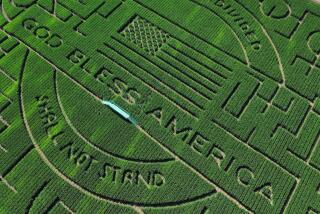It’s not corny -- Midwest maze is a fall tradition
- Share via
FARMLAND, IND. — As the autumn air grows crisp and the groves of maple and oak trees warm this stretch of eastern Indiana with streaks of red and burnt gold, Maureen “Mo” Jester prepares for her favorite time of year: getting lost in the corn.
Eight years ago, Jester decided that she and her family needed to make a bit of extra cash to support their 65-acre farm. So she and business partner Darren Coulter sat down at her kitchen table with graph paper and felt-tip pens and figured out how to transform some land into an agrarian take on the hedge mazes found on English manors.
The idea, she said, was to draw city dwellers into the autumn joys of picking pumpkins, going on a hay ride and losing their way in the fields, where towering cornstalks obscure everything but the sky.
“It was getting harder to make a living each year,” said Jester, 41, who grew up on a ranch in Wyoming and taught agriculture courses at several Midwestern schools before buying this Indiana parcel in the late 1990s. “If you have a small amount of ground, you either have to grow and get big or keep your small farm and have an off-farm source of income.”
For Jester, the decision to turn her farm into a rural theme park turned out to be a profitable one.
Now, every fall, tens of thousands of people roam 1 Fun Farm, sip hot cocoa and enjoy what has become an annual tradition.
“There’s something about fall that screams corn maze,” said Patty Randall, 34, a Sunday school teacher from First Presbyterian Church in Bluffton, Ind. Church volunteers have brought kids to the maze for the last four years.
“I don’t know if it’s the cold or the leaves turning or how the air smells of corn cobs burning on the bonfire, but October’s not October without a trip to the farm.”
Crop mazes have been used for ceremonial purposes for centuries. The modern version sprouted in the early 1990s thanks to British maze-developer Adrian Fisher, who is credited with creating the first corn maze in Pennsylvania.
After that, the race was on to create the biggest, strangest or scariest labyrinth.
From the ground, maze-travelers see a seemingly endless series of twisting paths with an occasional clue along the way. But from the air, it’s clear these mazes are living works of art.
This season, a giant cowboy stretches across the fields in Angleton, Texas, while dinosaurs tromp across the Dan-D Farms in Knoxville, Iowa. The Great Sphinx and the pyramids of Giza cover the Hawes Farms in Anderson, Calif. Military planes and Marine helicopters occupy part of the Corona family ranch in Temecula.
All told, there are an estimated 500 mazes across the country, said Kamille Combs, spokeswoman for The MAiZE, a leading corn-maze design firm based in Utah.
“Families like to do things that create traditions around holidays, and it’s tough to take little kids and the grandparents to a haunted house every October,” Combs said. “But visiting a farm is something that feeds people’s sense of nostalgia and appeals to all ages.”
Jester’s maze started out relatively low-key. Once they had their initial design -- an outline of the state of Indiana, with basketball and barn shapes cut inside -- she hired a professional maze-design firm for guidance. Days on a tractor turned 10.2 acres into loops and zigzag paths stretching for more than two miles.
They opened in mid-September 2001 and kept the maze running through Halloween.
Most farmers follow this seasonal calendar, Combs said.
“It can get pretty warm out there in the fields in the summer, and getting lost in the maze when it’s hot out is not everyone’s idea of fun. Any later and the days get cold,” she said.
Jester even allows visitors to roam through the “haunted” fields at night: Local high school and college students hide in the stalks and jump out to scare passersby.
On a recent Sunday afternoon, Charlie Couch jogged after his son Cody, 8, who was giggling as he barreled down the stalk-lined, dirt-and-husk covered path.
Father and son have trekked from their Indianapolis home to this rural community of 1,500 each October since Cody was old enough to walk.
“My wife and I have pictures of him in front of this corn-maze entrance from each year on our mantle,” said Couch, 42, a software programmer. “We came out once, just on a whim, and he had so much fun we kept coming back. I’ve learned to wear comfortable shoes.”
On this trip, though, after 45 minutes, the Couches were completely lost. When they reached a fork in the maze, the child skidded to a stop.
“We should go left, Dad,” said Cody, grinning. “Maybe.”
Couch, with sore feet and a fading sense of humor, shrugged and turned left.
--
More to Read
Sign up for The Wild
We’ll help you find the best places to hike, bike and run, as well as the perfect silent spots for meditation and yoga.
You may occasionally receive promotional content from the Los Angeles Times.






